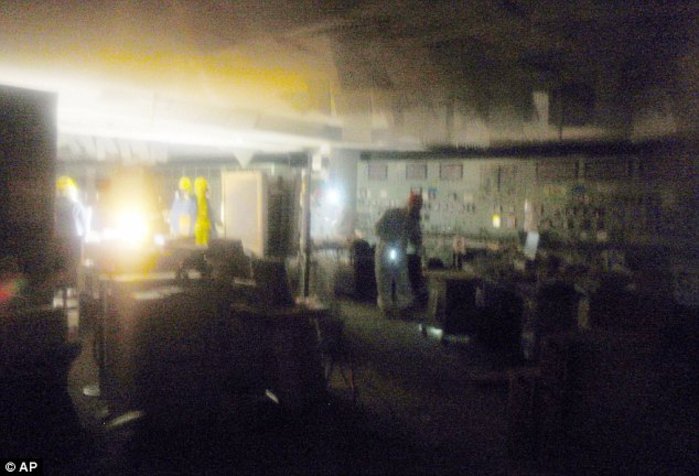Between 2012 and 2014 we posted a number of articles on contemporary affairs without giving them volume and issue numbers or dates. Often the date can be determined from internal evidence in the article, but sometimes not. We have decided retrospectively to list all of them as Volume 10, Issue 54 with a date of 2012 with the understanding that all were published between 2012 and 2014.
By the APJ editors — Updated March 25 This report introduces the first photographs of TEPCO workers inside the plant, the accounts of family members together with recent reports on the present status of the six reactors at Fukushima Daiichi.
The Daily Mail has published a series of photos that show the ongoing work at the plant. This is the first look at the individuals working to cool the reactors at great personal risk. There are now as many as 200 working around the clock in rotating teams in order to limit exposure to radiation.
The daughter of one of the workers has written on Twitter: “My dad went to the nuclear plant, I’ve never seen my mother cry so hard. People at the plant are struggling, sacrificing themselves to protect you. Please dad come back alive.”
On the 23rd, Sankei reported that radiation inside the No. 2 reactor building reached 500 millisieverts, prompting a temporary suspension of repair work. A level of 100 would result in negative health effects for an unprotected adult. TEPCO (Tokyo Electric Power Company) has denied these reports, saying that the estimates were mistaken. On the 24th, two workers were hospitalized after they were exposed to radiation at reactor No. 3. The condition of all six Fukushima reactors as of 10 PM on March 24 (Japan) is described here in an analysis by the Japan Atomic Industrial Forum which points to severe problems at reactors 1,2,3, and 4. The data is drawn from reports by Japan’s Nuclear and Industrial Safety Agency and TEPCO.
As more reports of serious injuries emerge, we should not simply be celebrating the heroism of the Fukushima workers, but also lamenting the fact that they have been placed in this position in the first place. Nuclear Ginza, a 1995 Japanese TV documentary, with English subtitles and voiceover added for airing by the UKs Channel Four, highlights the long history of safety oversights and abuses in Japan’s nuclear industry, showing the effects of under-regulation and corporate irresponsibility on ordinary workers, many of them drawn from the ranks of burakumin and sent in to do cleanup work with no protection, little awareness of the risk, and little training.
The Scientist has looked at research regarding radiation exposure in order to give a clearer picture of the risks that could emerge at Fukushima. William Schull, an emeritus professor at the University of Texas Health Science Center in Houston is quoted as saying “Radiation levels currently being reported by Japanese officials [as of the 22nd] are still quite low, and the early public evacuation reduced the concern for community health risk… But the workers at the nuclear plants still risked acute radiation exposure and serious health problems as a result.” He warns as well that “things could quickly worsen.”
The site links to a Radiation Dose Chart that measures different levels of risk. On cancer risks, The Scientist also reports: “An increased risk of cancer is epidemiologically detectable starting at exposures of 150 to 200 millisieverts (mSv) of radiation, said John Boice cancer epidemiologist at The Vanderbilt-Ingram Cancer Center and former chief of the Radiation Epidemiology Branch at the National Cancer Institute. This is a concern for the Fukushima plant workers, who may have been exposed to levels ranging from 200-400 mSv per hour.” They also confirm “The most recent estimates [on the 24th] from the US Department of Energy (DOE) assert that the levels of radiation outside the Fukushima Daiichi nuclear plant are well below the threshold that would pose an immediate risk to the local residents.”
There are reasons to believe, however, that some scientists commenting on this issue in the press may not be following the most recent numbers released by the Japanese government. A Ministry of Education press release reveals hourly measures of 65 micro sieverts in an outdoors area just outside of the 30km evacuation zone. If an individual were to be exposed to that much radiation for a year, they would be at 237 the average yearly dose of 2400, putting them at elevated cancer risk. While the numbers in Tokyo on the 24th are still a tiny fraction of this at 0.134 micro sieverts per hour, elevated levels in areas to the north of the Fukushima plant show that this crisis is far from over.
In The New Yorker, renowned Japanese novelist Oe Kenzaburo makes an impassioned appeal to turn the crisis into a catalyst for change: “The Japanese should not be thinking of nuclear energy in terms of industrial productivity; they should not draw from the tragedy of Hiroshima a “recipe” for growth. Like earthquakes, tsunamis, and other natural calamities, the experience of Hiroshima should be etched into human memory: it was even more dramatic a catastrophe than those natural disasters precisely because it was man-made. To repeat the error by exhibiting, through the construction of nuclear reactors, the same disrespect for human life is the worst possible betrayal of the memory of Hiroshima’s victims.”
Recent reports from Fukushima take an increasingly serious tone. The Nikkei reported trouble at reactor No. 1 and No. 3 on the evening of the 25th. The Associated Press reports that TEPCO suspects that a serious breach may have taken place at reactor No. 3.









